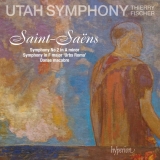 Camille Saint-Saëns: Symphonie Nr. 2 + Symphonie F-Dur Urbs Roma + Danse macabre op. 40; Utah Symphony, Thierry Fischer; 1 CD Hyperion CDA68212; Aufnahme 2017/2018, Veröffentlichung 03/05/2019 (72'38) – Rezension von Remy Franck
Camille Saint-Saëns: Symphonie Nr. 2 + Symphonie F-Dur Urbs Roma + Danse macabre op. 40; Utah Symphony, Thierry Fischer; 1 CD Hyperion CDA68212; Aufnahme 2017/2018, Veröffentlichung 03/05/2019 (72'38) – Rezension von Remy Franck
Die zweite Folge der Saint-Saëns-Reihe aus Utah bestätigt den guten Eindruck der ersten. Der Schweizer Dirigent Thierry Fischer gibt der 2. Symphonie einen frühromantischen Charakter, mit deutlicher Betonung der klassischen Elemente. Sie wird im ersten Satz, dem Scherzo und dem Finale Prestissimo, mit viel Elan und Pulsation wiedergegeben. Im Adagio gibt es eine schöne Mischung aus Nostalgie und Wärme. Das Orchester aus Utah klingt sehr schön ausbalanciert und überzeugt mit warmen Farben.
Die Sinfonie F-Dur mit dem Untertitel Urbs Roma (Stadt Rom) komponierte Saint-Saëns 1857, im Alter von 22 Jahren. Auch hier greift Fischers Konzept eines geschmeidigen und nie schweren Orchesterklangs, obwohl er durchaus expressiv, jedoch ohne Pathos musizieren lässt. Der Komponist hatte dieses Werk mit viel Herzblut geschrieben, weil er damit den Prix de Rome gewinnen wollte, was ihm aber nicht gelang. Er gewann aber immerhin den ersten Preis des Kompositionswettbewerbs der ‘Société Sainte-Cécile’.
Die ‘Danse Macabre’ ist in einer ganz besonders gut gelungenen Interpretation zu hören. Sie ist nicht nur tänzerisch beschwingt, sondern hat auch etwas Drängendes, das gut zu der Musik passt.
The second volume of the Saint-Saëns series from Utah confirms the good impression of the first. Swiss conductor Thierry Fischer gives the 2nd Symphony an early romantic character, with a clear emphasis on the classical elements. The first movement, the Scherzo and the Finale Prestissimo have much verve and pulsation. In the Adagio there is a beautiful mixture of nostalgia and warmth. The orchestra from Utah sounds very well balanced and convinces with warm colours. The Symphony Urbs Roma (City of Rome) was composed by Saint-Saëns in 1857, at the age of 22. Fischer’s concept of a supple and never heavy orchestral sound is again very efficient here, even though he allows the music to be played in an expressive way, but without pathos. The composer composed this work with a great deal of passion, because he wanted to win the Prix de Rome, but failed to do so. The Danse Macabre can be heard in a particularly successful performance. It is not only dance-like and lively, but also has something urgent that makes it very exciting.
























